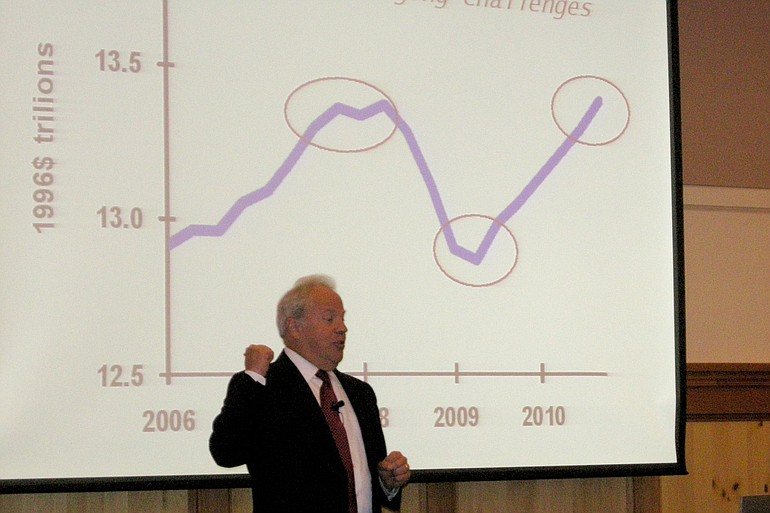As a measure of who has a job and who’s looking for one, Clark County’s monthly unemployment rate shines a light on our economy and speaks to the security of the labor pool.
It also lies to us.
Not in the way a person tells a fib, but in the way a statistic — based on solid, yet limited data — doesn’t tell the whole story. While Clark County’s December jobless rate, 12.9 percent, is in the right territory, it’s not on the mark.
The U.S. Bureau of Labor Statistics publishes alternative measures of unemployment that account for such factors as discouraged workers — people who want to work but don’t think there are jobs available to them so they give up looking — and part-time workers who would prefer to be working full time.
However, such alternative measures are available only for the national and state levels.
The only way to find out how many, say, discouraged workers there are in Clark County would be to ask around. And that would involve spending a lot of money to hire an army of interviewers to conduct the appropriate survey.
The U.S. Bureau of Labor Statistics publishes alternative measures of unemployment that account for such factors as discouraged workers -- people who want to work but don't think there are jobs available to them so they give up looking -- and part-time workers who would prefer to be working full time.
However, such alternative measures are available only for the national and state levels.
The only way to find out how many, say, discouraged workers there are in Clark County would be to ask around. And that would involve spending a lot of money to hire an army of interviewers to conduct the appropriate survey.
Take it from Scott Bailey, a regional labor economist for the state Employment Security Department who crunches the numbers for Southwest Washington, including Clark County: “It’s a ballpark indicator,” he said, “but not a precise measurement.”
But what, exactly, is our unemployment rate based on? And how much stock should we put in it?
Population survey key
The answer begins with carefully crafted questions.
Every month, the federal government surveys 60,000 of the country’s estimated 114.8 million households.
In addition to unemployment rates, every month the Washington Employment Security Department releases numbers showing jobs added, lost or unchanged by industry.
The industry-by-industry job numbers come from two different sets of data: a survey of employers and quarterly unemployment insurance tax returns.
The federal Current Employment Statistics program surveys about 140,000 businesses and government agencies on employment, hours and earnings of workers on nonfarm payrolls. It provides sample data that can be used in estimating state and local job numbers.
The quarterly tax returns provide information about every employer in Washington by county and industry, including employee head counts, and wages and hours worked.
Put the CES data and the tax-return information together, and you can produce monthly and year-over-year estimates showing which industries are adding or cutting jobs, or staying the same.
Surveyors ask people questions designed to figure out which of three basic labor market categories they fall into: people who have jobs are the employed; people who don’t have jobs but who are actively searching are the unemployed; and people who are neither employed nor unemployed, such as retirees or full-time students, are not counted as part of the labor force.
In addition to unemployment rates, every month the Washington Employment Security Department releases numbers showing jobs added, lost or unchanged by industry.
The industry-by-industry job numbers come from two different sets of data: a survey of employers and quarterly unemployment insurance tax returns.
The federal Current Employment Statistics program surveys about 140,000 businesses and government agencies on employment, hours and earnings of workers on nonfarm payrolls. It provides sample data that can be used in estimating state and local job numbers.
The quarterly tax returns provide information about every employer in Washington by county and industry, including employee head counts, and wages and hours worked.
Put the CES data and the tax-return information together, and you can produce monthly and year-over-year estimates showing which industries are adding or cutting jobs, or staying the same.
The nation’s unemployment rate is the number of unemployed people divided by the labor force.
It’s not a perfect count, but because so many households are surveyed the margin of error is small. It’s within plus or minus one-tenth of 1 percent, Bailey said. That means the estimated U.S. unemployment rate for January — 9 percent — was within a range of 8.9 percent to 9.1 percent.
There’s more room for error when state economists look at Washington’s slice of the federal survey, which includes 1,600 households.
Analysts don’t just divide the unemployed population into the labor force. Instead, they also consider past household surveys, state unemployment claims, information from a monthly federal survey of employers and estimates of farm employment.
Every state uses the same approach, said Dennis Reid of the U.S. Bureau of Labor Statistics San Francisco regional office.
“We use the same methodology, so we can compare the unemployment rates of Vancouver to a small town in Mississippi.”
The result is an estimate of unemployment that’s within eight-tenths of 1 percent, Bailey said. That means Washington’s unemployment rate in December 2010 — 9.3 percent — was accurate within a range of 8.5 percent to 10.1 percent.
Margins of error
There is no equivalent household survey designed to cull comprehensive jobs data for counties. And Clark County’s slice of Washington’s slice of the federal household survey data is so small that it’s basically irrelevant. As few as 30 Clark County households have been part of the survey in recent years.
Instead, Clark and other Washington counties are like pieces in an equation that must add up. Analysts tally how many residents of this county have applied for unemployment, review surveys of employers and look into other data sources, and plug them into a computerized model they’ve fine-tuned over the past seven decades.
That model adjusts each county’s jobless rate up or down based on the data provided, and makes sure that the figure makes mathematical sense given the official state-level number.
There’s no way to produce a margin of error for a county’s jobless rate, Bailey said, because the figure is based purely on a computer model.
However, there are ways to double-check whether it’s in the right territory.
For example, Clark County has one of the highest unemployment rates in Washington. To be sure that’s accurate when other counties in the state have also been hit hard by job losses, factor in the Portland metro area. The data show that Clark County residents who commute to Portland have been more likely to lose their jobs, and that has pushed up this county’s unemployment rate, Bailey said.
Unemployment insurance claims can also help corroborate the county’s jobless rate. If claims increased by 2 percent across the state but went up by 3 percent in Clark County, that confirms that the county’s jobless numbers should be higher than the state average.
Imperfect but useful
“Higher than average” is hardly exact, yet each month the state releases an unemployment number for Clark County based on its best estimates.
“Take it with a grain of salt in terms of its precision,” Bailey said of the county’s monthly jobless rate. “But, in terms of its direction and in terms of a general reading of the economy, it’s pretty darn good.”
Bill Conerly, an economist and principal of Lake Oswego, Ore.-based Conerly Consulting LLC, echoes Bailey’s assessment, saying we do a “pretty good job” of measuring our local and national labor markets.
The important thing to remember, he said, is that “there’s a range of uncertainty” to consider in deciding how much weight to give to the official numbers.
Even the federal survey data are fallible, because it’s possible that some people aren’t giving straight answers about their work status, Conerly said.
Adding to the uncertainty, the sample data are relatively small on the national level and even smaller on the state level.
“We don’t ask everybody, ‘Are you working?’” Conerly said.
While he has doubts about the quality of the labor market data, Conerly said he’s not concerned about the quality of the analysts who process the information for national, state and local consumption.
“There’s certainly no conspiracy to manipulate the numbers,” he said. “The folks working on this are solid analysts, and they’ve been asked to do a difficult job.”




